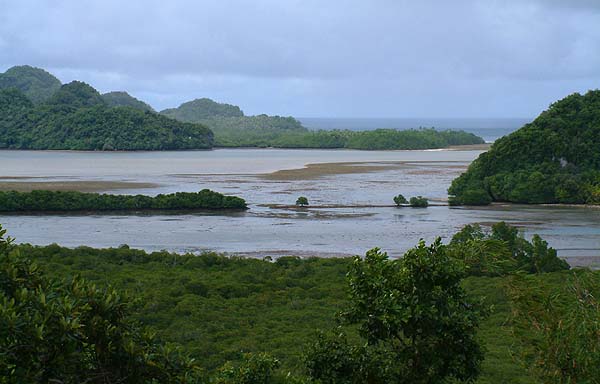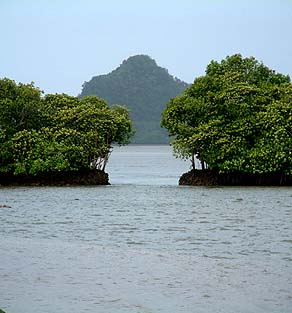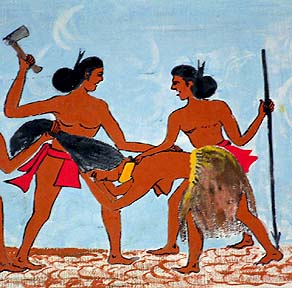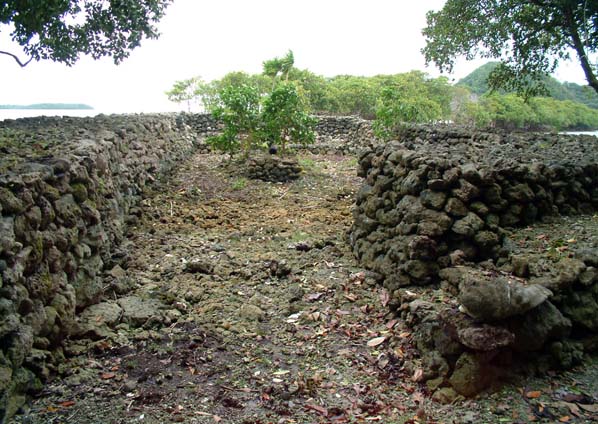 |
 |
 |
 |
||||
|
|
|
|
|
|
|
|
|
|
|
|||||||
|
“Palau is divided into two confederations," explain the Airai chiefs. "One side is controlled by Ibedul (title of the high chief of Oreor, now Koror) and the side controlled by Reklai (title of the high chief of Melekeok). So you can divide the whole of Palau into these two divisions. And Airai Village is in between both places, geographically and politically. We sit right in the middle of both centers of power, and we’re like a neutral country. We can go either way. "At the shore, we have two channels or meeting places. One for the Ibedul, and one for Reklai. Consequently Airai Village is known among the Palauans as Tóilbeluu. Beluu is land. Tói is a passage where the canoe can go through. So Tóilbeluu means it's a village where both the people from Melekeok, high chief Reklai, and the people from Koror, high chief Ibedul, can pass through without any impediments or without any interference. It's like a neutral place for both high chiefs.So it's called Tóilbeluu or ‘the place where you pass through.’
|
||
|
|
||
|
"From the dock, you can see the causeway which reaches from the shoreline all the way to the Rock Island. It's kind of a barrier that divides the two divisions of Palau, the east side and the west side. The causeway is reversed because it was done by Medechiibelau, who always liked to do things the opposite way. So the base of the pier is at the Rock Island and the end is at the shore; instead of the beginning or base being on the mainland, the base is on the Rock Island and coming in toward Airai Village. "But that causeway divides east and west. If somebody from the east side offended Koror people and started chasing them, and they rowed their canoe, once they passed that they were safe. That is the division line."
|
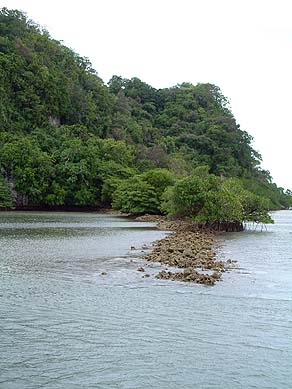
|
|
“Warfare then was territorial: about
fishing grounds, about fertile grounds and sometimes revenge. In the
old days, if people in the village were anti-social, you either killed
them or banished them. And then they’d create trouble. But basically
it was about territory. In the old days the boundaries were very flexible,
depending upon power struggles. Boundary matters were renegotiated with
the chiefs, otherwise they resorted to fighting. And people lived together
in one place for self-defense in the old days. You did’t trust
the next village. Life was not so pleasant then. "But when the Germans came they tried to stabilize this country, this place. Now we have what we call charters, establishing boundaries. Even then we have disputes. In fact Airai just won a big boundary dispute with Aimeliik our neighboring state, where our boundary is way, way out there."
|
|
|
|
|
|
|
"Cut my head off:" “One time, Airai Village was being conquered by Ibedul and his confederation of Palau—what we call the Other Side of Heaven, the other side of Palau. Airai was conquered seven times, and one of the reasons is because it had a lot of Palauan money. So they came to take the money. When Ibedul came for the seventh time to conquer Airai, the lady came down from Esuroi—this house on the hill, the second ranking house in Airai Village. The chief there is Rdialul and the female chief is Dil. One morning the lagoon was filled with war canoes and warriors, and they realized they were about to take over the village. So the female chief from the second house of Airai, known as Dil, put that big piece of Palauan money on her neck, the yellow one. That's called kedám. Kedám means ‘kite’."
|
||
|
|
||
|
“At that time, there was no male title-bearer for that clan, so the woman was called Dil, the female head of the clan, put the biggest piece of Palauan money around her neck and then put turmeric ointment on her body and put on this grass skirt, and then she actually got into a canoe and went to another pier in the lagoon to confront the warriors. "She was sitting in a stately position in the middle of a canoe and approached the head of the invaders, showing her neck with a piece of Palauan money, and bent her head over and said, ‘leave, restore Airai to its peaceful status, and cut my head off as a trophy.’ Because, when men get into war they have to take a trophy home. And hers was a symbolic statement. When she bowed her head, they cut the string and took the trophy home, that Palauan money. And Airai Village was restored to its peaceful status."
|
|
|
|
|
|
“And that piece of Palauan money known as kedám was kept by Ibedul throughout the generations until about 1950 or1960, when the high chief Ibedul took it and cashed it in. That money is called ‘Land Restoration’ because it restored Airai to its peaceful position today. There's a Palauan word for it, Osumechelbeluu. So high chief Ibedul took the Palauan money, which was in his clan's possession for years, and gave it to the high-ranking woman from Reklai’s clan of Melekeok. And he said, ‘make sure you get the story right.’ "That woman was a beautiful lady. Her name was Ebilrechebong Sechedui Asanuma, and she is my wife's grandmother. That was given partly to serve as security for money he had borrowed from her, and part was chub—a gift, especially to a women, in hope of her affection. So today that money is in the hands of Reklai’s clan, the rival of Ibedul's clan. But it came from this house up on the hill. And my grandfather who raised me is from that clan. So it's a true story. ‘Cut my head off’.”
|
||
|
|
||
|
|
This rich history is revealed in the many sites that characterize Airai as a Native Place.
|
||
|
|
||
|
|
|
|
|
|

|
| Airai Home | Map Library | Site Map | Pacific Worlds Home |
|
|
|
|

|
|
|
|||
| Copyright 2003 Pacific Worlds & Associates • Usage Policy • Webmaster |
|||
